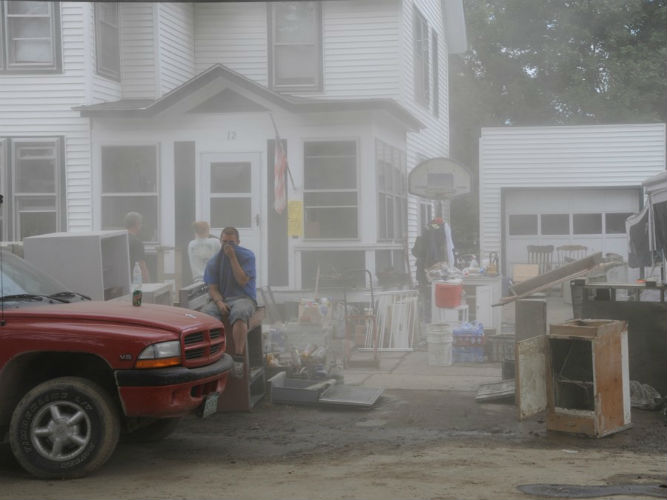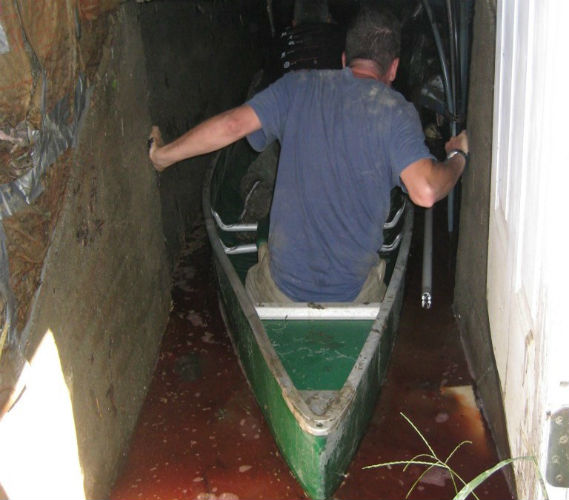Information for Flood-Damaged Communities
If you have a home or business that has been flooded, please visit vermont211.org or call: 211 or (218) 288-2213
Floodplain Managers and Municipal Officials - contact VT DEC if you would like additional help with permit questions ands Substantial Damage Estimation. Contact your floodplain manager or use the link below:
Contact VT DEC Here for Support for Permitting and Substantial Damage Estimation
- Substantial Damage Determinations
- Resources for Municipal Administrative Officers
- Information to Provide to Home and Business Owners
- Vermont’s Tropical Storm Irene Buyout Program: 2011-2021 Overview and Recommendations
- Have you experienced damage from flooding? Call 211

Resources for Municipal Administrative Officers
After a disaster, building owners and volunteers work to help the injured and displaced, to stabilize structures and make small emergency repairs. After this first emergency period the real repair work begins. Any permanent repairs need to be in compliance with your municipal bylaws under permit.
If a structure has extensive damage, then the Administrative Officer (AO/ZA) must make a determination as to whether the structure was Substantially Damaged, or, if the the repairs and additional improvements will constitute Substantial Improvement. If a structure is Substantially Damaged (SD) or Substantially Improved (SI), then the structure (or portions of it) must become properly elevated and flood safe according to the community regulations.
What is a substantially-damaged structure?
After flood damage, one of the critical but unfamiliar elements, is to determine if a structure has been Substantially Damaged (44 CFR §59.1)
Substantial damage means damage of any origin sustained by a structure whereby the cost of restoring the structure to it's before damaged condition would equal or exceed 50 percent of the market value of the structure before the damage occurred.
Any repairs to a substantially damaged structure must bring the structure into compliance with the community’s flood hazard area regulations. This requirement applies to substantial damage from any cause to a structure in the Special Flood Hazard Area.
Who makes Substantial Damage determinations?
Official Substantial Damage determinations can only be made by the community. Neither FEMA nor the State Floodplain Office (or any other State of Vermont office) can make a SD determination. However, the municipal Administrative Officer (AO or ZA) should coordinate with the DEC Regional Floodplain Manager during this process.
Here are key resources from VT DEC for communities making these determinations.
-
Contact VT DEC Here for Support for Permitting and Substantial Damage Estimation
-
VT SD Short Guide to Repairs, Restoration and Substantial Damage
-
A Draft Post for Public Information on Front Porch Forum and Your Municipal Website
-
Information Sheet to Print and Handout (Set printer to FIT sheet)
-
Damage Assessments - a short list of what happens after a Disaster
-
Substantial Improvement/ Substantial Damage Community Procedure 11-7-18 .pdf
-
Video recording of 7.20.23 Drop In Session on the SD Process Transcript Slides as .pdf
-
Video recording of Florida SDE Training 7/28/2023 (1:45) Slides as .pdf
If your community wants to adopt a different procedure for SI/SD determinations, this should be done in collaboration with your Regional Floodplain Manager. Such a procedure should be established before a determination is needed.
Other Resources for Community Administrative Officers
- SI SD Worksheet for applicants 11-7-18 - an Excel sheet with two tabs
- Substantial Improvement / Substantial Damage Unit 8 of FEMA 480 Desk Reference for Municipal Officials
- Substantial Improvement / Substantial Damage Desk Reference
- FEMA SDSI Checklist P-758 2010
- Development Review Submission Checklist - for VTDEC and 4424
- VT Template for a SD Determination Letter to the Building Owner
- Info Sheet: You Got a Substantial Damage Determination - Now What?
Can a Determination of Substantial Improvement/Substantial Damage be Appealed?
The Administrative Officer (AO / ZA) may request specific information from the applicant to inform and refine the determination. If specific cost information becomes available after the decision, the applicant has a defined period of time to appeal the AO's determination to the Development Review Board (DRB/ZBA).
What can our community do to help flood-damaged residences and businesses during post-flood recovery?
After a disaster the community wants to support the people injured or damaged by the event. After the emergency response period, and immediate efforts to stabilize damage, the permanent repairs need appropriate permits to meet hazard area standards.
To encourage rapid recovery with the necessary permitting, some Select Boards choose to waive permit fees for a specific period of time. In some circumstances Select Boards may choose to adopt short-term Interim Bylaws to expedite the permit process. The VT DEC Regional Floodplain Manager has examples of such Interim bylaws.
In the midst of the urgent response after damage, it is important to follow the rules so as to not bar property owners from getting valid damage assessments, getting insurance payments, and securing Small Business Administration Loans. A determination of Substantial Damage is necessary for certain funds such as the NFIP Increased Cost of Compliance (ICC) funds and some FEMA Hazard Mitigation Assistance programs.
What about damage to structures located outside of the FEMA 100-year floodplain?
The NFIP requirements for Substantial Improvement/Substantial Damage only apply within the Special Flood Hazard Area. If a structure was very near the mapped boundary then it would be good to discuss this situation with your Regional Floodplain Manager.

More Information for Home or Business Owners
- After the Flood factsheet
- Don't Do It Twice! Flood Damage Resistant Materials Guide
- Flood Damage-Resistant Materials Requirements TB 2 1/2025
- Before you Begin Repairs - flowchart
- Repairing your flooded home - FEMA 234
- Planning for Tomorrow's Flood - VT ACCD
- Flood Preparation Toolbox - a series of concise information sheets, checklists and more advanced tools
- Disaster Recovery Guide for Businesses - contains checklists; to do lists
- Lake Wise - Shoreland Best Management Practices
- Lake Shoreland Permit Program
